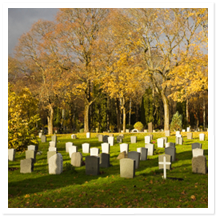 For hundreds of years grave markers have been used in cemeteries around the world. Cemetery markers are an indicator of a loved one’s final resting place and are a permanent memorial to the person. Cemetery markers vary from one another in terms of size, materials, textures, and designs.
For hundreds of years grave markers have been used in cemeteries around the world. Cemetery markers are an indicator of a loved one’s final resting place and are a permanent memorial to the person. Cemetery markers vary from one another in terms of size, materials, textures, and designs.
Cemetery markers have evolved throughout time with new materials and engraving techniques available today. However, their purpose is the same as ever – to give identity and memorialize a dead individual.
When choosing from the different types of cemetery markers, one must consider many options. The monument size, shape, color, lettering style and imagery are all choices you will need to make. Monument size is particularly important as most cemeteries have restrictions on length and height. The imagery engraved on the marker is also regulated and may have to be approved by the cemetery.
Cemetery Markers
Flat Markers
Flat markers are also called flush markers or grass markers. They typically feature a smaller amount of text than other types of markets. They are usually made up of bronze or granite. As the name suggests, this kind of markers is flat and is typically only 1 inch above the ground.
Mausoleum
A mausoleum is a structure mounted on the ground to serve as housing for a loved dead person. It is a freestanding building constructed as a monument enclosing the interment space of a deceased person or persons. Mausoleums come in many different styles and colors and can be very expensive to construct.
Companion markers
Companion markers are made for two people or partners such as wife and husband. They are typically larger than single markers because of their need to accommodate two names.
Pillow and Bevel markers
Pillow or bevel markers resemble flat markers and instead of being flat, these markers are slightly slanted. These markers are set on a base above the ground and the top of the marker is typically polished. Because bevel markers sit above ground level they are easier to locate from a distance.
Foot markers
Foot markers are put at the foot of a grave. Foot markers have become far less common.
Open-book markers
The marker resembles an open book, typically symbolizing a bible. This design of marker was commonly used in cemeteries from the 1100′s to the early 1900′s. Open-book markers can still be found today, but are very uncommon.
Ground ledger markers
Ground ledger markers are bulkier than most of cemetery markers. They are in a shape of a grave and usually made of granite, marble or sandstone. Ledgers cover the entire grave surface and are set on curbing which surrounds the grave plot. Ledgers may be used alone or may be used in conjunction with headstones or other memorial objects.
Plaque markers
These markers are usually made of bronze and brass. It could be either on an elevated foundation that is partially slanted or set into the ground. The letterings on the markers could either be bronze and brass too. When it is in bronze, the letterings are raised. On the other hand, the letterings are incised or carved when brass is used.
Upright markers
Upright markers, also called headstones, is a stone that is sculptured and carved as a monument and comes in different shapes and sizes. Headstones can be shaped like rough slabs of granite, custom shaped, highly or partially polished, engraved, etc. Personalized headstones such as teddy bears, motorcycles or hearts could also be processed.
Choosing from the types of cemetery markers listed above can be a difficult decision. You should consider your budget, the location and the desired monument design. After you have selected a marker, you need to decide what inscription you want engraved on the marker. View the other articles on monuments below to learn more about how to personalize your loved one’s marker.
